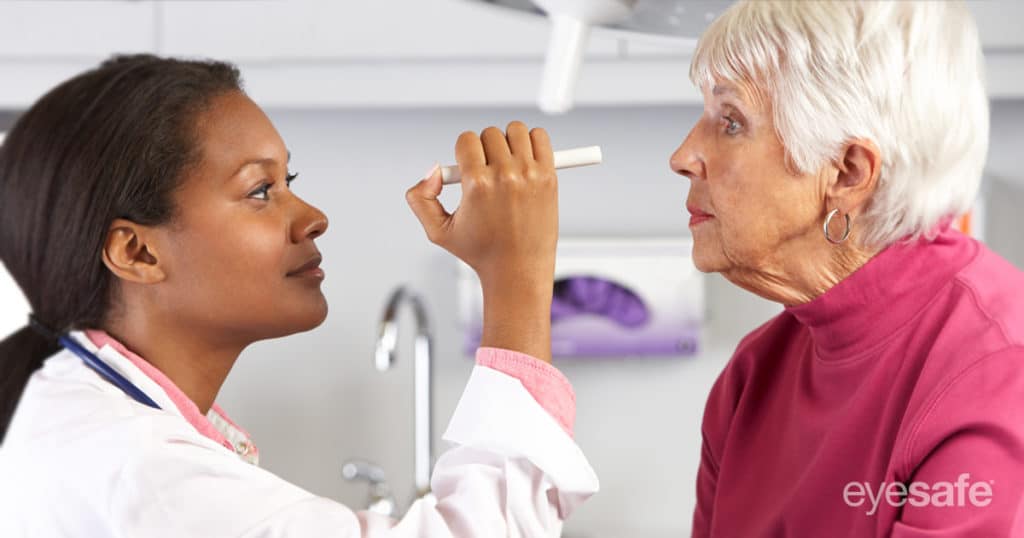April is Women’s Eye Health & Safety month, and we’d be remiss if we didn’t address the unique concerns facing women. When talking about eye health, men and women are not on equal footing. As cited by the National Eye Institute:
“The troubling reality [is] two-thirds of the world’s population of blind and visually impaired persons are women. Loss of vision is a quality-of-life issue, affecting one’s ability to live independently, contribute to society, and experience life to its fullest. Up to 80 percent of blindness and visual impairment are preventable or treatable; therefore, prevention through education is one key to saving sight.”
There are several reasons for this difference. First women tend to live longer than men, which mean their eyes will age and they are more susceptible to eye diseases and conditions developing late in life. The second reason is due to the hormonal changes happening through the life of every woman, from puberty to post-menopause. These hormonal changes have a bearing on many health conditions, including vision. Among the eye diseases more prevalent in women, we find dry eye syndrome, cataracts, glaucoma, and macular degeneration.
Cataract is a progressive opacification, or clouding, of the lens, with blurry, clouded or dim vision as main symptom, increasing difficulties seeing at night and a need to change prescriptions more often. Cataract can be treated by surgery, a simple outpatient procedure during which the old lens is replaced by a clear synthetic lens.
Glaucoma, a severe eye condition and the second-leading cause of blindness worldwide, is actually a group of diseases resulting in a pressure built up inside the ocular chamber, damaging the eye’s optic nerve, which if untreated, can lead to vision loss and even blindness. When blindness occurs from glaucoma, it is irreversible, so early detection is key. Anyone can get glaucoma, but the older a person is, the more likely they are to develop it.

Finally, dry eye disease occurs 2 to 3 times more frequently in women, and symptoms are often stronger for women compared to men. Dry eye is a multifactorial disease of the ocular surface and tear film, resulting in discomfort, pain, burning sensations, feeling of an object in the eye, visual acuity and visual disturbance; clinical signs and patient-reported symptoms are quite variable, and the disease requires diagnosis by an eye care professional. For women, pregnancy, birth control, hormone therapy and menopause are risk factors, as they provoke important hormonal changes which interact with tear production and alter the balance at the ocular surface. There is also a link between dry eye disease and autoimmune disorders which seem to affect women more than men.
Observing vision changes as we age can be normal; however, it is recommended to consult an eye care professional if symptoms occur. An annual eye checkup should be on everyone’s routine.
This article should not be considered medical advice; please consult an eye care professional to diagnose and treat any concerns related to eye health and vision.
Sources:
Women’s Eye Health | National Eye Institute (nih.gov)
The Glaucoma Research Foundation https://www.glaucoma.org/
The Discovery Eye Foundation : Women’s Eye Health By Susan DeRemer, March 10, 2016. https://discoveryeye.org/womens-eye-health/
What vision issues are unique to women? By Jill Neimark, All About Vision, January 2021. https://www.allaboutvision.com/conditions/women-and-vision/
Surprising impacts your hormones have on your vision. By Essilor News. https://www.essilorusa.com/newsroom/how-do-hormones-effect-your-eyes
Dry Eye Disease: Consideration for Women’s Health. C. Matossian, M. McDonald, K.E. Donaldson, K.K. Nichols, et al., Journal of women’s health, 2019. 28(4): p. 502-514. 10.1089/jwh.2018.7041
TFOS DEWS II Sex, Gender, and Hormones Report. D.A. Sullivan, E.M. Rocha, P. Aragona, J.A. Clayton, et al., The Ocular Surface, 2017. 15(3): p. 284-333. 10.1016/j.jtos.2017.04.001
How to Save Your Eyes in the Digital Age: The Handbook for Eye Care and Electronics https://shop.eyesafe.com/how-to-save-your-eyes-in-the-digital-age/
